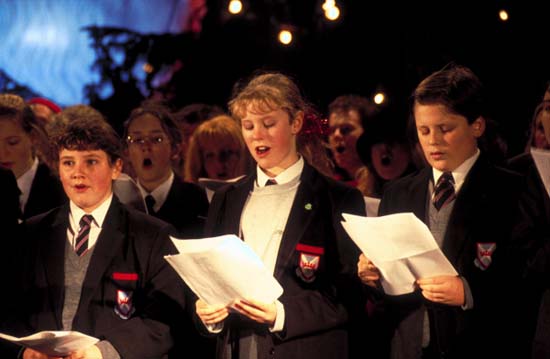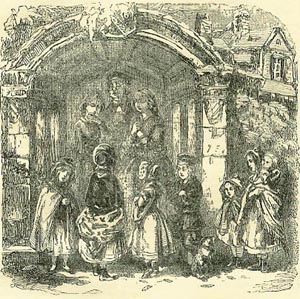Carols, Wassailers, Waits and Mummers
by Julia Hickey
God rest ye merry, gentlemen
Let nothing you dismay
Remember, Christ, our Saviour
Was born on Christmas day
To save us all from Satan's power
When we were gone astray
O tidings of comfort and joy,
Comfort and joy
O tidings of comfort and joy
Christmas just wouldn't be Christmas without carols like God
Rest Ye Merry, Gentlemen. (Note that the carol is not aimed
at "merry gentlemen," but urges gentlemen to "rest ye merry.")
For many people in Britain, Christmas really begins at the moment
when the carol service from King's College, Cambridge, is
broadcast -- a tradition that began in 1928. The service of nine
lessons and carols at King's took shape in 1918, and since 1919,
even during the dark days of World War Two, the first carol has
always been Once in Royal David's City.
 For some, Christmas carols will be forever associated with a
Salvation Army band; for others, a nativity service at school.
And then of course there are assorted carol services across the
country in cathedrals, churches and chapels. There is nothing
quite like a cathedral carol service -- the music of the choir
accompanied by soaring organ notes and the raised voices of the
congregation lift the experience beyond a visit to an empty
building, and the cathedral comes to life. Of course, there's
also nothing quite like a Midnight Mass celebrated in a parish
church. People come quietly out of the stillness of the night to
celebrate Christ's birth with well loved Christmas hymns, to
share friendship and exchange greetings before returning through
the frosty air to their homes. It seems a ritual that has been
passed from generation to generation, century after century.
For some, Christmas carols will be forever associated with a
Salvation Army band; for others, a nativity service at school.
And then of course there are assorted carol services across the
country in cathedrals, churches and chapels. There is nothing
quite like a cathedral carol service -- the music of the choir
accompanied by soaring organ notes and the raised voices of the
congregation lift the experience beyond a visit to an empty
building, and the cathedral comes to life. Of course, there's
also nothing quite like a Midnight Mass celebrated in a parish
church. People come quietly out of the stillness of the night to
celebrate Christ's birth with well loved Christmas hymns, to
share friendship and exchange greetings before returning through
the frosty air to their homes. It seems a ritual that has been
passed from generation to generation, century after century.
And so it has -- just not in church! As late as 1435, Church
Councils condemned carols as pagan practices, and the Puritans
banned them along with mince pies in 1647. It took another 150
years for carols to recover. Perhaps this is not too surprising,
given that one of the oldest carols, The Holly and the Ivy
-- thought to be over a thousand years old -- has little to do
with the nativity in its original form. Another, The Boar's
Head Carol -- written during the 12th century -- clearly has
even less to do with the celebration of Christ's birth and much
more to do with the merrymaking from which the word carol is
derived. "Carol" originally came from an old French word meaning
a jolly ring dance; the song went with the dance.
Here We Come a Wassailing is about merrymaking and
ensuring good fortune and a heavy apple yield for the following
year. Wassail comes from an Anglo Saxon word that means good
health. Groups of labourers -- wassailers -- would travel from
orchard to orchard wassailing the trees to drive away evil
spirits and ensure a good crop the following year. The custom is
still practised in parts of Somerset, Dorset and Devon.
Wassailers were, and still are, given money and a heady brew
called lamb's wool that definitely gives a warm glow to the
festive season! (For more information, see Here We Go A-Wassailing.)
 Early Church
Fathers may have frowned upon the merry carol tunes that invited
folk to dance and be happy, but ordinary people used them to
celebrate Christmas with gusto. As early as 1300 groups of waits
(night watchmen) were forming groups and singing and dancing
their way through carols for the entertainment of their
neighbours and to earn a few extra pence or flagon of ale from
the gentlefolk they watched over. God Rest Ye Merry,
Gentlemen wasn't formally recorded for many centuries, but it
is thought to be a 15th century waits carol. Early Church
Fathers may have frowned upon the merry carol tunes that invited
folk to dance and be happy, but ordinary people used them to
celebrate Christmas with gusto. As early as 1300 groups of waits
(night watchmen) were forming groups and singing and dancing
their way through carols for the entertainment of their
neighbours and to earn a few extra pence or flagon of ale from
the gentlefolk they watched over. God Rest Ye Merry,
Gentlemen wasn't formally recorded for many centuries, but it
is thought to be a 15th century waits carol.
At the start of the 18th century, the only really well known
carol to find its way into the hymn book was While Shepherds
Watched Their Flocks, which was written during the 17th
century. Gradually, though, carols were becoming respectable.
The dissenting churches recognised the power of the carol as an
act of celebration. Charles Wesley wrote Hark the Herald
Angels Sing, and O Come All Ye Faithful was also
written during this time. Even so, carol services were still
relatively unusual when Charles Dickens wrote A Christmas
Carol in 1843 -- though the ghost of Christmas Present, with
his desire for feasting, singing, dancing and general enjoyment,
would undoubtedly have approved.
Times were changing! A number of Victorians wrote down the carols
they heard, collections were printed, and families gathered to
sing from them at Christmas. Collections of carols remain
popular today -- there are some beautifully illustrated examples.
Respectability was finally achieved in 1878 when the choir of
Turo Cathedral sang their carols inside the cathedral rather than
in the streets of the city. The story of the nativity was told in
nine lessons interspaced with carols, which brings us back to the
carols from King's College Cambridge, which uses the same
format.
The dancing element of caroling has fared less well. Records
from medieval times show that kings and commoners threw
themselves into midwinter revelry with troupes of guisers or
mummers providing light-hearted entertainment. A beautifully
illustrated manuscript in the Bodleian Library in Oxford shows
the elaborate costumes and animal masks worn by court
entertainers in the reign of Edward III. The actors -- all men
-- were called guisers because they were disguised by animal
masks. Mummers -- also all men -- might wear masks or might
blacken their faces to disguise themselves. If the audience were
to recognise one of the players, the magic created by the
performance would be lost. Masques and performances continued to
be part of the Christmas celebrations at court throughout the
Tudor and Jacobean periods.
Folk plays performed by ordinary men for their communities also
thrived. Each is slightly different, as might be expected, but
all follow the same basic plot. A knight confronts his enemy,
one of them is slain and then revived by a 'Doctor'. The theme of
the play -- nature's cycle of life and death -- is definitely
pagan. The play concludes with celebrations, a hat is passed
around for people to give money and ale is offered to the
players. One of the characters is often called St. George;
another (the one usually killed and then revived) is called the
Turk. His appearance dates back to the crusades. Elsewhere this
role may be that of real historical character. The fear with
which Cromwell and Napoleon were regarded is reflected in their
appearance in these plays. Often, there is also a man dressed as
a woman, and by the 18th century Father Christmas had joined the
ranks of the players as a narrator. The plays were written down
in the 18th century at a time when they were beginning to decline
in popularity; perhaps the lure of the new Christmas theatricals
was too great.
Despite their relative decline following industrialisation, the
plays have survived in pockets across the country; Belvoir,
Leominster, North Muskham and Overton all have annual
performances. These folk plays are real community entertainment
and the costumes are brilliant. Often, the mummers wear 'ribbon'
costumes, like fitted rag rugs, completing the ensemble with a
hat and bells. It's a spectacle not to be missed. If you won't
be in England at Christmas, there are opportunities to see
Mummers in Cheshire celebrating Halloween and in the Upper Calder
valley in Yorkshire celebrating Easter.
Caroling may be very far removed from dancing in a circle, but
one thing is for sure: there's still much merriment to be found
in the season of carols and winter plays. Why not take the
opportunity to attend a carol service? It may not be the middle
of the bleak midwinter and there may be no snow falling but the
atmosphere in a church or cathedral at Christmas time is
indescribably, spine-tingling ethereal. Or perhaps accept the
National Trust's invitation to one of England's stately homes to
listen to a choir and partake of a mince pie. Leave the hustle
and bustle of the world neatly parked outside and indulge
yourself. There is something timeless about listening to a choir
in a recital room, ball room or great hall. There are full
details on the Trust's web site. Cromwell wouldn't approve but
generations of waits, carol singers, wassailers, guisers and
mummers most definitely would!
More Information:
We regret that we no longer have the resources to maintain up-to-date links and/or hours and pricing details for the various sites and attractions listed on this website. For more information about the location(s) listed above, please use your favorite search engine or visit Wikipedia.
Suggested Reading:
Spirit of Christmas: A History of Our Best-Loved Carols
The Oxford Book of Carols
Mummers
Julia Hickey is passionate about England's heritage and particularly of Cumbria, where her husband comes from. In between dragging her family around the country to a variety of historic monuments, she works part-time as a senior lecturer at Sheffield Hallam University. She spends the rest of her week writing. In her spare time, she enjoys walking, dabbling in family history, cross-stitch, tapestry and photography.
Article © 2005 Julia Hickey
Carolers photo courtesy of BritainOnView.com
|
